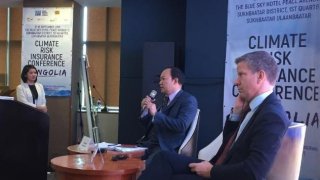National emergency management drives inclusive climate risk insurance in Mongolia
By Dirk Reinhard, Vice Chairman, Munich Re Foundation; Diana Almoro, Senior Advisor, GIZ RFPI Asia
properties.trackTitle
properties.trackSubtitle
Insurance plays an important role in the new Mongolian regulatory framework to prevent disasters which was introduced in 2017. A substantial part of the country’s GDP still comes from agricultural income. Climate risks therefore play a particular role in the efforts to make the country more resilient against economic shocks. However, there is still a long way to go to reach the vulnerable population that particularly depends on income from livestock.
Mongolia is the second largest landlocked country in the world with a total population of about 3 million people. Of the around 900,000 Mongolian households, over 70 % live in “Ger households” - Ger is the traditional round shaped dwelling – i.e. in the traditional homes or individual houses in rather remote areas. According to insurance experts, only a few of them have insurance. Agricultural production in particular income from livestock today accounts for around 10% of the national GDP. Climatic events called "Dzud" are a predominant risk to the country’s economy. Multiple natural disasters consisting of a summer drought which results in inadequate pasture and production of hay followed by a very hard winter storm (Dzud) have had a severe impact on herders livelihoods. Catastrophic events between 1999 and 2002 caused a livestock mortality of about 11 million animals. Between 2009 and 2010, the Mongolian GDP dropped by 4.4% due to extreme weather events.
|

Governmental action leads to protection
In 2006 Mongolia introduced the Index-Based Livestock Insurance (IBLI). Today around 338,000 herders' or about 20% of the total herding households are covered. The scheme is composed of two thresholds. Livestock mortality of up to 6% has to be borne by the herders. Between 6-30% livestock mortality, an insurance covers the losses. The premium of that layer is paid by the insureds. Above 30% a reinsurance covers the losses for which the reinsurance premium is paid by the government of Mongolia. The scheme is voluntary. Losses are calculated based on livestock mortality based by type of animal within certain regions (Soum).
Despite the big losses in 2009 the scheme is still running and premium from IBLI has grown to nearly 3.5 billion MTN (about 1.2 million EUR) according to IBLI’s reinsurer Mongolian Re. One of the success factors is the cooperation between the government and the insurance industry. IBLI is not only an insurance scheme but includes an IBLI law that clearly defines the responsibilities of the government such as paying the reinsurance premium covering the costs for a half-yearly livestock census which is the basis for calculating the livestock mortality and thus the trigger for the pay-out.
Key factors to achieve inclusive climate risk insurance
The example of IBLI shows that governmental involvement can lead to a sustainable insurance scheme. Other examples e.g. from Indonesia showcased that support of the agricultural sector with a subsidized insurance program has led to the involvement of over 70 insurance companies in the inclusive insurance sector. And programs are being extended as other governmental agencies step in. After a request from the Ministry of Maritime Affairs in Indonesia, an insurance for shrimp farmers has been developed and implemented.

Another important role of government agencies is the provision of data such as data that help to improve the understanding of the market, weather data or even data on losses as in the case of IBLI – as a basis for the calculation of insurance products. “Data is the new oil” said Mark Rüegg, CEO of the Swiss-based provider of digital services for parametric insurance solutions CelsiusPro. Technology has undergone a rapid development in the recent years and will improve data quality substantially through the availability and increasing number of sources such as satellites, weather stations, sensors or mobile phone. The latter also play a key role in implementing efficient distribution models e.g. through the use of mobile payment schemes. However, the lack of an enabling legal framework as well as lack of appropriate skills slows down the use of technology as speakers from different countries agreed.
Insurance needs to be an integral part of disaster risk reduction (DRR) measures said Antonis Malagardis. The different agencies involved in DRR need to better understand their mandate and role and improve cooperation also with the insurance industry e.g. in the form of public private partnerships (PPPs). To be successful, countries should develop a national financial inclusion strategy, define clear goals and roles of all stakeholders and have a strong coordinator was a recommendation by Dirk Reinhard, Vice Chairman of the Munich Re Foundation. Experts agreed that the National Emergency Management Agency of Mongolia (NEMA) could play such a strong coordinating role in the country.
The way forward
RFPI Asia together with its partners will take all possible measures to make the MEFIN network sustainable as an inclusive insurance forum as well as a knowledge management and data hub on climate risk insurance issues. An immediate priority will be to collaborate with the MEFIN partners to convene the key authorities/actors on fiscal policy, disaster risk reduction and management, climate change and insurance to bridge information gaps and promote harmonization. The MEFIN program will continue the discussions in a pre-conference at the 15th International Conference on Inclusive Insurance which will be held from 5-7 November in Dhaka, Bangladesh.

About the event
The Mutual Exchange Forum on Exclusive Insurance (MEFIN) is a Network of insurance regulators/supervisors working closely with the insurance industry in seven jurisdictions. It has been organizing public private dialogues (PPDs) since 2016 aiming at discussing policy reforms and proportionate regulations for inclusive insurance.